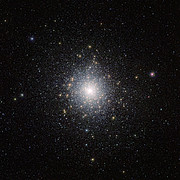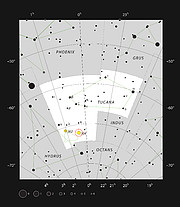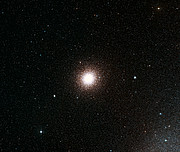Komunikat prasowy
Galimatias gwiazd egzotycznych
Nowe zdjęcie gromady gwiazd 47 Tucanae z teleskopu VISTA
10 stycznia 2013
To podczerwone zdjęcie z teleskopu VISTA ukazuje w szczegółach gromadę kulistą 47 Tucanae. Gromada zawiera miliony gwiazd, a wiele z nich, znajdujących się w jądrze, to gwiazdy egzotyczne o nietypowych własnościach. Badania obiektów w gromadach takich jak 47 Tucanae mogą nam pomóc w jaki sposób te dziwne kule powstają i oddziałują. Zdjęcie jest bardzo ostre i głębokie dzięki rozmiarowi, czułości i położeniu VISTA w Obserwatorium ESO Paranal w Chile.
Gromady kuliste to ogromne, sferyczne chmury starych gwiazd, związanych razem przez grawitację. Występują jako obiekty krążące wokół jąder galaktyk, podobnie jak sztuczne satelity wokół Ziemi. Te gwiezdne zgromadzenia zawierają bardzo mało gazu i pyłu – uważa się, że jego większość została albo wywiana z gromady przez wiatry lub wybuchy gwiazd w niej zawartych, albo usunięta przez gaz międzygwiazdowy oddziałujący z gromadą. Pozostały materiał uformował gwiazdy miliardy lat temu.
Owe gromady kuliste wywołują znaczne zainteresowanie astronomów – 47 Tucanae, znana także jako NGC 104, jest wielką gromadą znajdującą się około 15 000 lat świetlnych od nas i wiadomo, że zawiera wiele dziwnych i interesujących gwiazd i układów.
Widoczna w południowym gwiazdozbiorze Tukana, 47 Tucanae okrąża naszą Drogę Mleczną. Ze średnicą 120 lat świetlnych jest tak duża, że pomimo odległości, ma na niebie rozmiar prawie tak duży jak tarcza Księżyca. Zawierając miliony gwiazd jest jedną z najjaśniejszych i najmasywniejszych znanych gromad kulistych i widać ją gołym okiem [1]. Pośród wirującej masy gwiazd, w sercu gromady, znajdują się intrygujące systemy, w tym źródła promieniowania X, gwiazdy zmienne, „gwiezdne wampiry”, niespodziewanie jasne „zwykłe” gwiazdy znane jako błękitni maruderzy (eso1243) oraz niewielkie obiekty nazywane pulsarami milisekundowymi, małe, martwe gwiazdy, które obracają się niesamowicie szybko [2].
Czerwone olbrzymy, gwiazdy, które wyczerpały paliwo w swoich jądrach i zwiększyły rozmiar, są rozproszone na zdjęciu z VISTA i łatwo je dostrzec, gdy świecą w kolorze bursztynu na te jasnych biało-żółtych gwiazd tła. Gęsto upakowane jądro jest kontrastem dla bardziej rzadkich obszarów zewnętrznych gromady, oraz wielkiej liczby gwiazd tła z Małego Obłoku Magellana.
Zdjęcie uzyskano za pomocą należącego do ESO teleskopu VISTA (Visible and Infrared Survey Telescope for Astronomy) w ramach przeglądu Obłoków Magellana, dwóch najbliższych galaktyk względem naszej. 47 Tucanae, mimo iż znacznie bliższa niż Obłoki Magellana, przypadkiem widoczna jest na tle Małego Obłoku Magellana (eso1008) i została sfotografowana w ramach przeglądu.
VISTA to największy na świecie teleskop dedykowany wykonywaniu map nieba. Ten położony w Obserwatorium ESO Paranal w Chile teleskop podczerwony, z wielkim zwierciadłem, szerokim polem widzenia i czułymi detektorami, ukazuje nowe widoki nieba południowego. Korzystając z połączenia ostrych zdjęć podczerwonych – takich jak zaprezentowane – i obserwacji w zakresie widzialnym, astronomowie mogą dokładnie badać zawartość i historię obiektów takich jak 47 Tucanae.
Uwagi
[1] Istnieje około 150 gromad kulistych okrążających naszą galaktykę. 47 Tucanae jest drugą najmasywniejszą po Omega Centauri (eso0844).
[2] Pulsary milisekundowe są niezwykle szybko rotującymi wersjami zwykłych pulsarów, mocno namagnesowanymi, obracającymi się pozostałościami gwiazdowymi, które emitują promieniowanie w trakcie rotacji. Znane są 23 pulsary milisekundowe w 47 Tucanae – więcej niż we wszystkich innych gromadach, oprócz Terzan 5 (eso0945).
Kontakt
Richard Hook
ESO, La Silla, Paranal, E-ELT & Survey Telescopes Press Officer
Garching bei München, Germany
Tel.: +49 89 3200 6655
Tel. kom.: +49 151 1537 3591
E-mail: rhook@eso.org
Krzysztof Czart (Kontakt dla mediów Polska)
Sieć Popularyzacji Nauki ESO
oraz Urania - Postępy Astronomii
Toruń, Polska
Tel.: +48 513 733 282
E-mail: eson-poland@eso.org
O komunikacie
| Komunikat nr: | eso1302pl |
| Nazwa: | NGC 104 |
| Typ: | Milky Way : Star : Grouping : Cluster : Globular |
| Facility: | Visible and Infrared Survey Telescope for Astronomy |
| Instrumenty: | VIRCAM |
Our use of Cookies
We use cookies that are essential for accessing our websites and using our services. We also use cookies to analyse, measure and improve our websites’ performance, to enable content sharing via social media and to display media content hosted on third-party platforms.
ESO Cookies Policy
The European Organisation for Astronomical Research in the Southern Hemisphere (ESO) is the pre-eminent intergovernmental science and technology organisation in astronomy. It carries out an ambitious programme focused on the design, construction and operation of powerful ground-based observing facilities for astronomy.
This Cookies Policy is intended to provide clarity by outlining the cookies used on the ESO public websites, their functions, the options you have for controlling them, and the ways you can contact us for additional details.
What are cookies?
Cookies are small pieces of data stored on your device by websites you visit. They serve various purposes, such as remembering login credentials and preferences and enhance your browsing experience.
Categories of cookies we use
Essential cookies (always active): These cookies are strictly necessary for the proper functioning of our website. Without these cookies, the website cannot operate correctly, and certain services, such as logging in or accessing secure areas, may not be available; because they are essential for the website’s operation, they cannot be disabled.
Functional Cookies: These cookies enhance your browsing experience by enabling additional features and personalization, such as remembering your preferences and settings. While not strictly necessary for the website to function, they improve usability and convenience; these cookies are only placed if you provide your consent.
Analytics cookies: These cookies collect information about how visitors interact with our website, such as which pages are visited most often and how users navigate the site. This data helps us improve website performance, optimize content, and enhance the user experience; these cookies are only placed if you provide your consent. We use the following analytics cookies.
Matomo Cookies:
This website uses Matomo (formerly Piwik), an open source software which enables the statistical analysis of website visits. Matomo uses cookies (text files) which are saved on your computer and which allow us to analyze how you use our website. The website user information generated by the cookies will only be saved on the servers of our IT Department. We use this information to analyze www.eso.org visits and to prepare reports on website activities. These data will not be disclosed to third parties.
On behalf of ESO, Matomo will use this information for the purpose of evaluating your use of the website, compiling reports on website activity and providing other services relating to website activity and internet usage.
Matomo cookies settings:
Additional Third-party cookies on ESO websites: some of our pages display content from external providers, e.g. YouTube.
Such third-party services are outside of ESO control and may, at any time, change their terms of service, use of cookies, etc.
YouTube: Some videos on the ESO website are embedded from ESO’s official YouTube channel. We have enabled YouTube’s privacy-enhanced mode, meaning that no cookies are set unless the user actively clicks on the video to play it. Additionally, in this mode, YouTube does not store any personally identifiable cookie data for embedded video playbacks. For more details, please refer to YouTube’s embedding videos information page.
Cookies can also be classified based on the following elements.
Regarding the domain, there are:
- First-party cookies, set by the website you are currently visiting. They are stored by the same domain that you are browsing and are used to enhance your experience on that site;
- Third-party cookies, set by a domain other than the one you are currently visiting.
As for their duration, cookies can be:
- Browser-session cookies, which are deleted when the user closes the browser;
- Stored cookies, which stay on the user's device for a predetermined period of time.
How to manage cookies
Cookie settings: You can modify your cookie choices for the ESO webpages at any time by clicking on the link Cookie settings at the bottom of any page.
In your browser: If you wish to delete cookies or instruct your browser to delete or block cookies by default, please visit the help pages of your browser:
Please be aware that if you delete or decline cookies, certain functionalities of our website may be not be available and your browsing experience may be affected.
You can set most browsers to prevent any cookies being placed on your device, but you may then have to manually adjust some preferences every time you visit a site/page. And some services and functionalities may not work properly at all (e.g. profile logging-in, shop check out).
Updates to the ESO Cookies Policy
The ESO Cookies Policy may be subject to future updates, which will be made available on this page.
Additional information
For any queries related to cookies, please contact: pdprATesoDOTorg.
As ESO public webpages are managed by our Department of Communication, your questions will be dealt with the support of the said Department.




